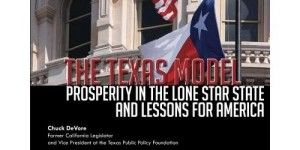California Taxes Success, Texas Taxes Results of Success
By Wayne Lusvardi
Chuck DeVore’s timely new book, “The Texas Model: Prosperity in the Lone Star State and Lessons for America,” can be summed up in one riveting sentence by him: “California taxes success, while Texas taxes the results of success.”
This not only sums up DeVore’s very readable explanation of what makes Texas’s prosperity different from California’s stagflation. It sums up the DeVore family’s pilgrimage from Hudson Valley, N.Y. to Irvine, Calif. and to Dripping Springs, Tex., a bucolic semi-rural hamlet on the outskirts of the state capital of Austin. Chuck is a retired lieutenant colonel in the California Army National Guard, a former aerospace executive and a former California assemblyman. He now is a senior fellow in fiscal policy at the Texas Public Policy Foundation.
Relocation, not retreat
DeVore is a self-described “numbers guy” who has a nose for the bottom line. He was vice chairman of the California State Assembly Committee on Revenue and Taxation and has a degree in strategic studies from Claremont McKenna College. His book is a combination of the numerical and the entrepreneurial.
DeVore is an entrepreneur for prosperity and liberty, as well as a hard-nosed analyst. But his book is not Texas “boosterism” or a disgruntled rant about the deterioration of the “California Dream.” The book can be useful for elected decision makers, educated voters wanting to find a new model for California, or those contemplating relocating to Texas.
As DeVore writes, “People don’t casually vote with their feet” to leave their native home. He explains that some of the data shown in the book were used for him to make a decision whether to transplant his family in Texas or not. DeVore’s migration was not because of a fad or only a protest to what is happening in California. He explains it as a decision based on a convergence of hard economics and his value system of prosperity being the residue of liberty.
DeVore cannot be typecast as an ideological refugee, seeking asylum behind the walls of the Alamo. He’s a military man and a fighter who had to relocate his family for economic and personal reasons. DeVore had to find a place to relocate his wife’s elderly parents from rural New York, two teenage children and his cancer-survivor wife. His former modest home was unable to accommodate all of them given Irvine’s high real estate values.
Texas model: Tax incentives for business and job formation
The core of DeVore’s book is a comparison of two hypothetical small businessmen in San Diego and Dallas in his chapter “Tax a Little, Get a Lot.” DeVore shows what happens when each makes $100,000, $125,000, and $200,000 gross income in California and Texas.
Comparison of California and Texas Business Tax Rates
| San Diego Business Owner | Dallas Business Owner | Higher California Taxes and Tax Rates | |
| SCENARIO 1: $100,000 GROSS BUSINESS INCOME | |||
| Marital Status | Married | Married | |
| Pay themselves | $100,000 | $100,000 | |
| Overall tax rate on gross income | 8.4% | 8.26% | 0.14% |
| Total state & local tax liability | $8,396 | $8,256 | $140 |
| SCENARIO 2: $125,000 GROSS BUSINESS INCOME | |||
| Pay themselves | $125,000 | $125,000 | |
| Overall tax rate | 11.6% | 9.2% | 2.4% |
| Total state & local tax liability | $14,500 | $11,500 | $3,000 |
| SCENARIO 3: $200,000 GROSS BUSINESS INCOME | |||
| Pay themselves | $200,000 | $200,000 | |
| Overall tax rate | 10.3% | 4.6% | 5.7% |
| Total state & local tax liability | $20,600 | $9,200 | $11,400 |
At $100,000 gross income, both businessmen are taxed about equally in both states. At $125,000, Texas shows a slight tax advantage. But if a businessman takes more risks to boost his income to $200,000, the Texas businessman sees no additional state taxes. On the other hand, the Californian sees his “income tax bill go from $2,491 to $11,655, a tax increase of 368 percent on an income increase of 143 percent.” Texas not only preaches a prosperity ideology, it rewards it; while California overtaxes jobs and wealth creation. As they say in the business world, a valuable product sells itself without much need of advertising.
However, DeVore isn’t content with just Chamber of Commerce boosterism. He answers critics that contend Texas owes its vitality to oil and low wages, lighter environmental regulations leading to air pollution, insufficient affordable housing, medical care inadequate for the poor, subpar education and a safety net full of holes. In each case, DeVore’s statistical reply to the critics of Texas’ economic model is devastating and convincing.
Personal observations about California vs. Texas models
As someone who assisted an 82-year-old lady to relocate from upscale San Marino in Southern California to her hometown of San Antonio, Tex. this past year, I have some observations of my own to add to what makes Texas prosperous and California’s economic model ultimately doomed.
As a former real estate appraiser, I observed that Texas doesn’t overinvest its family in real estate, especially residential homes. Home values in Texas are about half those in California’s for homes of similar size and quality in equal neighborhoods. As such, Texas has more stable capital to invest in family and business formation and a more stable tax base.
Texas is able to do this because it doesn’t have California-style growth management policies such as city annexation commissions, mandated environmental impact reports and lawsuits, general plans and housing element plans, open space preservation, the California Coastal Commission, the Lake Tahoe Regional Conservancy and the Tahoe Regional Planning Commission. Houston doesn’t even have zoning and instead uses neighborhood covenants.
What makes our state “California” is its image of ever-increasing home values. This is often captured by the popular phrase, “You can’t go wrong buying land or homes in California because the prices always go up in the long run.” And the reason they seem to always go up is because of California’s unique blend of growth controls, environmental land use regulations and Proposition 13. Although Prop. 13 limited tax increases on homes, in doing so it made home investment more profitable than the other, highly taxed sectors of the economy.
Combined with the political mania for affordable housing incentives — low interest rates, low down payments, and mortgage interest tax deductions — these factors produce home-price bubbles and busts.
The bubbles inflate home prices way beyond what family incomes can afford. This leads to NIMBY — “Not In My Backyard” — behavior to protect property values as personal fortunes. It also leads to families using built-up home equity from inflated price appreciation as collateral for business loans or unsustainable luxury lifestyles. But when the home equity goes “poof” during a real estate bust, what results is foreclosures, upside down mortgages, business closures and busted government budgets. Maybe architect Frank Lloyd Wright was accurate when he described California as a giant pinball machine that leads to government “casino” budgeting.
Toxic mix
But with this toxic mix of land use regulations and affordable housing incentives comes booms and busts that break state and local government and school district budgets that become addicted to the accompanying inflated property taxes.
Real estate bubbles have created the “California Dream.” But they have also created its economic nightmare. Texas’ “prosperity model” is based on lower tax rates on businesses that produce jobs and realistic real estate values tied to family incomes. California punishes job-creating businesses and over-inflates home prices beyond what most families can afford. I can attest that there is more affordable market-rate housing in upscale areas of Texas than in California.
The ultimate “dream” of California’s political Progressives is to get rid of Prop. 13, which allows property tax increases above 2 percent a year only when houses resell, instead of on an annual reassessment. But if growth controls are also not deregulated at the same time, it will lead to a gigantic economic disaster that would likely trigger another state, maybe even national, depression.
Check out DeVore’s book for a contrast with how things are done in California — and a path toward better policies for the Golden State.
Related Articles
Video: Jerry Brown’s biggest challenge in CA
Chapman University Law School Dean Tom Campbell explains to CalWatchdog.com’s editor-in-chief Brian Calle how he believes the biggest challenge Gov.
Shocking media development: An honest take on AB 32’s costs
Nov. 14, 2012 By Chris Reed Here’s how terrible California media coverage of AB 32 has been: Lots of people
Occidental ready to bring Bakken phenomenon to California
Nov. 15, 2012 By Chris Reed In my research for a U-T San Diego editorial that’s running today about fracking’s




